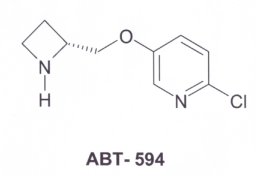
photo compliments of
Dr. Shin Sugiyama

Structure obtined from http://www.abdn.ac.uk/chemistry/abt
Abbott Laboratories in Abbott Park, Illinois first became interested in epibatidine in 1998 while developing experimental drugs for Alzheimer’s disease. Upon examination of epibatidine, researchers at Abbott Laboratories found that the compound was similar in structure to those being tested in their study. They were especially interested in the compound because of its non-opiod mechanism of action. While epibatidine itself could not be used because of its toxic effects, researchers began to develop epibatidine analogues with the hope of creating a compound that would work to combat pain without the side effects - such as respiratory depression, constipation, and physical dependence - associated with morphine. The best candidate developed was known as “ABT-594”. This epibatidine derivative seemed to achieve an effect similar to that of morphine without the side effects associated with opiod analgesics. While opiod analgesics are extremely effective in alleviating pain, many patients are unable to use them because of these intolerable side effects. Although further testing to determine whether or not ABT-594 will elicit any physical dependence - similar to that of nicotine - will be necessary, preliminary research indicates that ABT-594 may indeed be the answer to the prayers of those suffering from severe pain. (Strong, 1998)